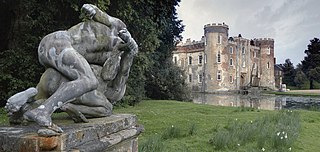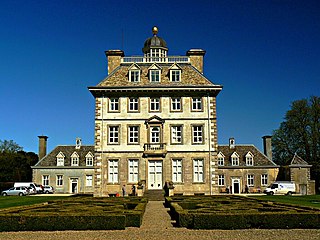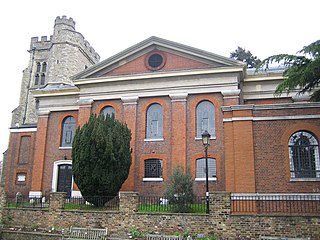
Alfred Tennyson, 1st Baron Tennyson was an English poet. He was the Poet Laureate during much of Queen Victoria's reign. In 1829, Tennyson was awarded the Chancellor's Gold Medal at Cambridge for one of his first pieces, "Timbuktu". He published his first solo collection of poems, Poems, Chiefly Lyrical, in 1830. "Claribel" and "Mariana", which remain some of Tennyson's most celebrated poems, were included in this volume. Although described by some critics as overly sentimental, his verse soon proved popular and brought Tennyson to the attention of well-known writers of the day, including Samuel Taylor Coleridge. Tennyson's early poetry, with its medievalism and powerful visual imagery, was a major influence on the Pre-Raphaelite Brotherhood.

Twickenham is a suburban district in London, England. It is situated on the River Thames 9.9 miles (15.9 km) southwest of Charing Cross. Historically part of Middlesex, it has formed part of the London Borough of Richmond upon Thames since 1965, and the borough council's administrative headquarters are located in the area.

Eel Pie Island is an 8.935-acre (3.6 ha) island in the River Thames at Twickenham in the London Borough of Richmond upon Thames. It is on the maintained minimum head of water above the only lock on the Tideway and is accessible by boat or from the left bank by footbridge. The island had a club that was a major venue for jazz and blues in the 1960s.

Hallam Tennyson, 2nd Baron Tennyson, was a British aristocrat who served as the second governor-general of Australia, in office from 1903 to 1904. He was previously Governor of South Australia from 1899 to 1902.

Goring-on-Thames is a village and civil parish on the River Thames in South Oxfordshire, Oxfordshire, England. It is located about 5+1⁄2 mi (9 km) south of Wallingford and 8 mi (13 km) north-west of Reading. It had a population of 3,187 in the 2011 census and was estimated to have increased to 3,335 by 2019.

Eel Pie Recording Studios, formerly Oceanic, was a recording studio located in The Boathouse, Twickenham on the banks of the River Thames in Ranelagh Drive, by Twickenham Bridge, West London, and also simultaneously at No. 45 Broadwick Street, Soho, London. The name for the studios came from the nearby Eel Pie Island, which was known as a major jazz and blues venue in the 1960s.

Shirburn Castle is a Grade I listed, moated castle located at the village of Shirburn, near Watlington, Oxfordshire. Originally constructed in the fourteenth century, it was renovated and remodelled in the Georgian era by Thomas Parker, the first Earl of Macclesfield who made it his family seat, and altered further in the early nineteenth century. The Earls of Macclesfield remained in residence until 2004, and the castle is still (2022) owned by the Macclesfield family company. It formerly contained an important, early eighteenth century library which, along with valuable paintings, sculptures, and other artifacts including furniture, remained in the ownership of the 9th Earl and were largely dispersed at auction following his departure from the property; notable among these items were George Stubbs's 1768 painting "Brood Mares and Foals", a record setter for the artist at auction in 2010, the Macclesfield Psalter, numerous rare and valuable books, and personal correspondence of Sir Isaac Newton.

Ashdown House is a 17th-century country house in the civil parish of Ashbury in the English county of Oxfordshire. Until 1974 the house was in the county of Berkshire, and the nearby village of Lambourn remains in that county.
Edward Hull was a British illustrator and watercolourist who exhibited at the Royal Academy in London. He was the brother of William Hull, another well known illustrator and watercolour painter.

Yelverton Lodge is an 18th-century hunting lodge on Richmond Road, Twickenham in the London Borough of Richmond upon Thames. Situated opposite Marble Hill Park and Marble Hill House, it was acquired for Henrietta Howard, Countess of Suffolk, who was a mistress of King George II.

Cornwell is a small village and civil parish about 2.5 miles (4 km) west of Chipping Norton in the West Oxfordshire district of Oxfordshire, near the county border with Gloucestershire. The 2001 Census recorded the parish's population as 66.
Chapel House may refer to:

Great Haseley is a village and civil parish in South Oxfordshire, England. The village is about 4.5 miles (7 km) southwest of Thame. The parish includes the hamlets of Latchford, Little Haseley and North Weston and the house, chapel and park of Rycote. The parish stretches 6 miles (10 km) along a northeast — southwest axis, bounded by the River Thame in the north, Haseley Brook in the south and partly by a boundary hedge with Little Milton parish in the west. The 2011 Census recorded a parish population of 511.

The Wick is a Grade I listed Georgian house in Richmond, Greater London, located at the corner of Nightingale Lane and Richmond Hill. The house, designed in 1775 by architect Robert Mylne for Lady St. Aubyn, was for many years the family home of actor Sir John Mills, who sold it to Ronnie Wood of the rock band Faces in 1971. From 1996 it was owned by Pete Townshend of the Who who sold it in 2021 for £15,000,000

Cote is a hamlet about 4 miles (6.4 km) south of Witney and 1 mile (1.6 km) north of the River Thames in West Oxfordshire, England. Cote is part of the civil parish of Aston, Cote, Shifford and Chimney. The hamlet of Cote stretches along Cote Lane, which seems to have originated as a road to a former crossing of the River Thames at Shifford.

Strawberry Hill House—often called simply Strawberry Hill—is a Gothic Revival villa that was built in Twickenham, London, by Horace Walpole (1717–1797) from 1749 onward. It is a typical example of the "Strawberry Hill Gothic" style of architecture, and it prefigured the nineteenth-century Gothic Revival.

The Boathouse is a commercial property located at Ranelagh Drive, Twickenham in England, which housed music and film studios.

St Mary's Church, Twickenham, also known as St Mary the Virgin, Twickenham, is a Grade II* listed Church of England place of worship dedicated to Saint Mary the Virgin. It is on Church Street, Twickenham in the London Borough of Richmond upon Thames, England.

Sandycombe Lodge is a Grade II* listed house at 40 Sandycoombe Road, Twickenham, in the London Borough of Richmond upon Thames. In the picturesque-cottage style, it was designed and built in 1813 by the artist J. M. W. Turner (1775–1851) as his country retreat and as a home for his father William (1745–1829). Turner lived there from 1814 to 1826. Originally known as Solus Lodge, it is the only surviving building designed by Turner, and shows the influence of his friend Sir John Soane. The appearance of the house had been much altered by the addition of second floors to the original side wings.

Twickenham Meadows, later known as Cambridge Park, was a 74-acre estate, the second largest estate in Twickenham, England, after Twickenham Park. It has now been built over and the name remains for a part of Twickenham in optional – station-centric terms – considered St Margarets. The estate included a three-storey brick Jacobean mansion which was built around 1610 and was later known as Cambridge House. The house was demolished in 1937






















